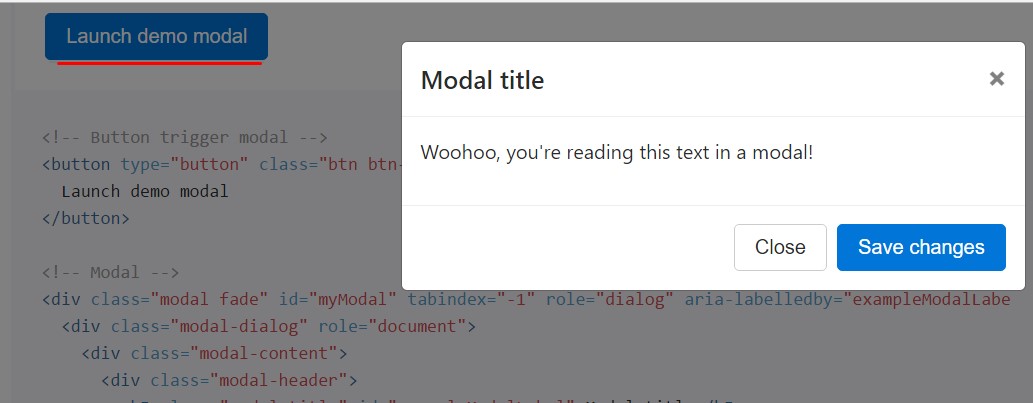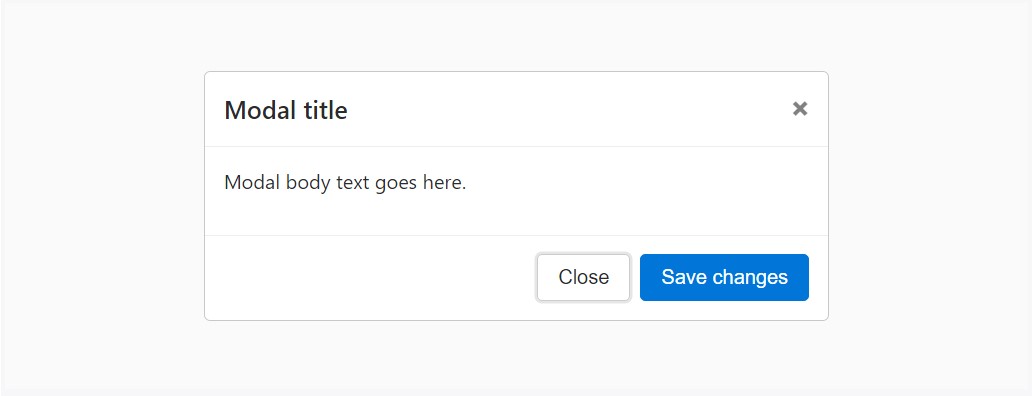Bootstrap Modal Box
Introduction
In some cases we really must set up the target on a specific data leaving every thing rest dimmed behind to get sure we have really obtained the targeted visitor's thought or perhaps have tons of details required to be available through the webpage yet so huge it definitely will bore and push the person checking over the web page.
For these types of scenarios the modal feature is pretty much invaluable. What exactly it works on is displaying a dialog box involving a huge area of the monitor diming out every thing other things.
The Bootstrap 4 framework has every thing required for generating this kind of feature having the minimum efforts and a practical intuitive structure.
Bootstrap Modal is streamlined, however, flexible dialog assists powered via JavaScript. They maintain a number of use samples starting with user alert ending with totally custom web content and offer a handful of valuable subcomponents, scales, and a lot more.
Information about how Bootstrap Modal Mobile performs
Before beginning with Bootstrap's modal element, be sure to read through the following because Bootstrap menu decisions have already changed.
- Modals are built with HTML, CSS, and JavaScript. They're located above everything else within the document and remove scroll from the
<body>- Clicking on the modal "backdrop" is going to immediately close the modal.
- Bootstrap typically supports just one modal window at once. Embedded modals aren't supported given that we believe them to remain bad user experiences.
- Modals usage
position:fixeda.modal- One once again , because of
position: fixed- In conclusion, the
autofocusContinue checking out for demos and application tips.
- As a result of how HTML5 identifies its semantics, the autofocus HTML attribute has no result in Bootstrap modals. To accomplish the identical result, work with some custom JavaScript:
$('#myModal').on('shown.bs.modal', function ()
$('#myInput').focus()
)To start we need to have a trigger-- an anchor or switch to be clicked so the modal to get displayed. To perform in this way simply appoint
data-toggle=" modal"data-target="#myModal-ID"Instruction
Now let us produce the Bootstrap Modal itself-- initially we really need a wrapper element containing the entire aspect-- specify it
.modalA great idea would undoubtedly be additionally including the
.fadeYou would certainly as well want to include the exact same ID that you have actually determined in the modal trigger considering that on the other hand if those two do not suit the trigger probably will not effectively fire the modal up.
Optionally you might want to incorporate a close tab inside the header delegating it the class
.closedata-dismiss="modal"Essentially this id the structure the modal parts have in the Bootstrap framework and it practically has remained the very same in both Bootstrap version 3 and 4. The brand-new version has a number of new solutions although it seems that the developers crew expected the modals do the job all right the approach they are and so they pointed their focus off them so far.
Right now, lets check out at the other forms of modals and their code.
Modal components
Shown below is a static modal example (meaning the
positiondisplaypadding<div class="modal fade">
<div class="modal-dialog" role="document">
<div class="modal-content">
<div class="modal-header">
<h5 class="modal-title">Modal title</h5>
<button type="button" class="close" data-dismiss="modal" aria-label="Close">
<span aria-hidden="true">×</span>
</button>
</div>
<div class="modal-body">
<p>Modal body text goes here.</p>
</div>
<div class="modal-footer">
<button type="button" class="btn btn-primary">Save changes</button>
<button type="button" class="btn btn-secondary" data-dismiss="modal">Close</button>
</div>
</div>
</div>
</div>Live test
Whenever you are going to employ a code listed below - a working modal demonstration will be provided as showned on the image. It will certainly move down and fade in from the very top of the webpage.

<!-- Button trigger modal -->
<button type="button" class="btn btn-primary" data-toggle="modal" data-target="#exampleModal">
Launch demo modal
</button>
<!-- Modal -->
<div class="modal fade" id="myModal" tabindex="-1" role="dialog" aria-labelledby="exampleModalLabel" aria-hidden="true">
<div class="modal-dialog" role="document">
<div class="modal-content">
<div class="modal-header">
<h5 class="modal-title" id="exampleModalLabel">Modal title</h5>
<button type="button" class="close" data-dismiss="modal" aria-label="Close">
<span aria-hidden="true">×</span>
</button>
</div>
<div class="modal-body">
...
</div>
<div class="modal-footer">
<button type="button" class="btn btn-secondary" data-dismiss="modal">Close</button>
<button type="button" class="btn btn-primary">Save changes</button>
</div>
</div>
</div>
</div>Scrolling expanded web content
They scroll independent of the page itself when modals become too long for the user's viewport or device. Work the demo listed below to see what exactly we mean ( discover more).

<!-- Button trigger modal -->
<button type="button" class="btn btn-primary" data-toggle="modal" data-target="#exampleModalLong">
Launch demo modal
</button>
<!-- Modal -->
<div class="modal fade" id="exampleModalLong" tabindex="-1" role="dialog" aria-labelledby="exampleModalLongTitle" aria-hidden="true">
<div class="modal-dialog" role="document">
<div class="modal-content">
<div class="modal-header">
<h5 class="modal-title" id="exampleModalLongTitle">Modal title</h5>
<button type="button" class="close" data-dismiss="modal" aria-label="Close">
<span aria-hidden="true">×</span>
</button>
</div>
<div class="modal-body">
...
</div>
<div class="modal-footer">
<button type="button" class="btn btn-secondary" data-dismiss="modal">Close</button>
<button type="button" class="btn btn-primary">Save changes</button>
</div>
</div>
</div>
</div>Tooltips along with popovers
Tooltips and also popovers can easily be set inside of modals just as needed. Once modals are shut off, any tooltips and popovers within are at the same time immediately dropped.

<div class="modal-body">
<h5>Popover in a modal</h5>
<p>This <a href="#" role="button" class="btn btn-secondary popover-test" title="Popover title" data-content="Popover body content is set in this attribute.">button</a> triggers a popover on click.</p>
<hr>
<h5>Tooltips in a modal</h5>
<p><a href="#" class="tooltip-test" title="Tooltip">This link</a> and <a href="#" class="tooltip-test" title="Tooltip">that link</a> have tooltips on hover.</p>
</div>Applying the grid
Use the Bootstrap grid system in a modal by nesting
.container-fluid.modal-body
<div class="modal-body">
<div class="container-fluid">
<div class="row">
<div class="col-md-4">.col-md-4</div>
<div class="col-md-4 col-md-offset-4">.col-md-4 .col-md-offset-4</div>
</div>
<div class="row">
<div class="col-md-3 col-md-offset-3">.col-md-3 .col-md-offset-3</div>
<div class="col-md-2 col-md-offset-4">.col-md-2 .col-md-offset-4</div>
</div>
<div class="row">
<div class="col-md-6 col-md-offset-3">.col-md-6 .col-md-offset-3</div>
</div>
<div class="row">
<div class="col-sm-9">
Level 1: .col-sm-9
<div class="row">
<div class="col-8 col-sm-6">
Level 2: .col-8 .col-sm-6
</div>
<div class="col-4 col-sm-6">
Level 2: .col-4 .col-sm-6
</div>
</div>
</div>
</div>
</div>
</div>Varying modal web content
Feature a number of buttons that all activate the very same modal using just a bit other components? Put to use
event.relatedTargetdata-*Shown below is a live demonstration nexted by example HTML and JavaScript. For additional information, read through the modal events docs for specifics on
relatedTarget

<button type="button" class="btn btn-primary" data-toggle="modal" data-target="#exampleModal" data-whatever="@mdo">Open modal for @mdo</button>
<button type="button" class="btn btn-primary" data-toggle="modal" data-target="#exampleModal" data-whatever="@fat">Open modal for @fat</button>
<button type="button" class="btn btn-primary" data-toggle="modal" data-target="#exampleModal" data-whatever="@getbootstrap">Open modal for @getbootstrap</button>
<div class="modal fade" id="exampleModal" tabindex="-1" role="dialog" aria-labelledby="exampleModalLabel" aria-hidden="true">
<div class="modal-dialog" role="document">
<div class="modal-content">
<div class="modal-header">
<h5 class="modal-title" id="exampleModalLabel">New message</h5>
<button type="button" class="close" data-dismiss="modal" aria-label="Close">
<span aria-hidden="true">×</span>
</button>
</div>
<div class="modal-body">
<form>
<div class="form-group">
<label for="recipient-name" class="form-control-label">Recipient:</label>
<input type="text" class="form-control" id="recipient-name">
</div>
<div class="form-group">
<label for="message-text" class="form-control-label">Message:</label>
<textarea class="form-control" id="message-text"></textarea>
</div>
</form>
</div>
<div class="modal-footer">
<button type="button" class="btn btn-secondary" data-dismiss="modal">Close</button>
<button type="button" class="btn btn-primary">Send message</button>
</div>
</div>
</div>
</div>$('#exampleModal').on('show.bs.modal', function (event)
var button = $(event.relatedTarget) // Button that triggered the modal
var recipient = button.data('whatever') // Extract info from data-* attributes
// If necessary, you could initiate an AJAX request here (and then do the updating in a callback).
// Update the modal's content. We'll use jQuery here, but you could use a data binding library or other methods instead.
var modal = $(this)
modal.find('.modal-title').text('New message to ' + recipient)
modal.find('.modal-body input').val(recipient)
)Take away animation
For modals that simply appear instead fade into view, get rid of the
.fade<div class="modal" tabindex="-1" role="dialog" aria-labelledby="..." aria-hidden="true">
...
</div>Lively heights
In case the height of a modal switch while at the same time it is exposed, you have to summon
$(' #myModal'). data(' bs.modal'). handleUpdate()Ease of access
Make sure to add
role="dialog"aria-labelledby="...".modalrole="document".modal-dialogaria-describedby.modalSetting YouTube video clips
Embedding YouTube video recordings in modals requires extra JavaScript not with Bootstrap to immediately put an end to playback and even more.
Optionally available scales
Modals possess two alternative sizes, readily available by using modifier classes to be inserted into a
.modal-dialog
<!-- Large modal -->
<button class="btn btn-primary" data-toggle="modal" data-target=".bd-example-modal-lg">Large modal</button>
<div class="modal fade bd-example-modal-lg" tabindex="-1" role="dialog" aria-labelledby="myLargeModalLabel" aria-hidden="true">
<div class="modal-dialog modal-lg">
<div class="modal-content">
...
</div>
</div>
</div>
<!-- Small modal -->
<button type="button" class="btn btn-primary" data-toggle="modal" data-target=".bd-example-modal-sm">Small modal</button>
<div class="modal fade bd-example-modal-sm" tabindex="-1" role="dialog" aria-labelledby="mySmallModalLabel" aria-hidden="true">
<div class="modal-dialog modal-sm">
<div class="modal-content">
...
</div>
</div>
</div>Application
The modal plugin toggles your invisible content as needed, by using information attributes or JavaScript. It even adds
.modal-open<body>.modal-backdropUsing data attributes
Switch on a modal with no creating JavaScript. Establish
data-toggle="modal"data-target="#foo"href="#foo"<button type="button" data-toggle="modal" data-target="#myModal">Launch modal</button>Via JavaScript
Call a modal using id
myModal$('#myModal'). modal( options).Possibilities
Opportunities may possibly be passed via details attributes or JavaScript. For data attributes, attach the option name to
data-data-backdrop=""Check also the image below:

Practices
.modal(options)
.modal(options)Turns on your content as a modal. Takes an optional options
object$('#myModal').modal(
keyboard: false
).modal('toggle')
.modal('toggle')Manually toggles a modal.
$('#myModal').modal('toggle').modal('show')
.modal('show')Manually initiates a modal. Returns to the caller just before the modal has really been demonstrated (i.e. before the
shown.bs.modal$('#myModal').modal('show').modal('hide')
.modal('hide')Manually covers up a modal. Go back to the caller before the modal has actually been concealed (i.e. before the
hidden.bs.modal$('#myModal').modal('hide')Bootstrap modals events
Bootstrap's modal class introduces a couple of events for netting into modal capability. All modal events are fired at the modal itself (i.e. at the
<div class="modal">
$('#myModal').on('hidden.bs.modal', function (e)
// do something...
)Final thoughts
We observed how the modal is developed but just what could probably be within it?
The response is-- literally all sorts ofthings-- starting with a very long phrases and forms plain section with certain titles to the highly complicated structure that utilizing the adaptive design methods of the Bootstrap framework could actually be a webpage in the page-- it is actually attainable and the option of incorporating it is up to you.
Do have in your thoughts though if ever at a specific point the material as being poured into the modal gets far too much possibly the better solution would be positioning the entire element into a individual web page in order to obtain rather more desirable appearance along with utilization of the whole display width attainable-- modals a suggested for smaller blocks of information advising for the viewer's treatment .
Inspect a couple of online video training regarding Bootstrap modals:
Related topics:
Bootstrap modals: official documents

W3schools:Bootstrap modal guide

Bootstrap 4 with remote modal

